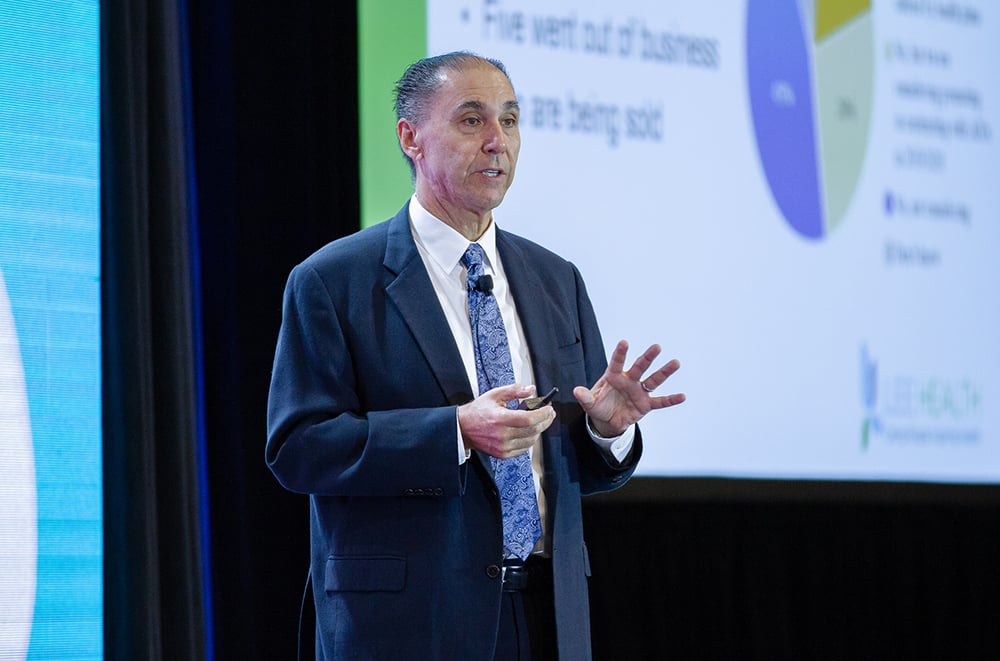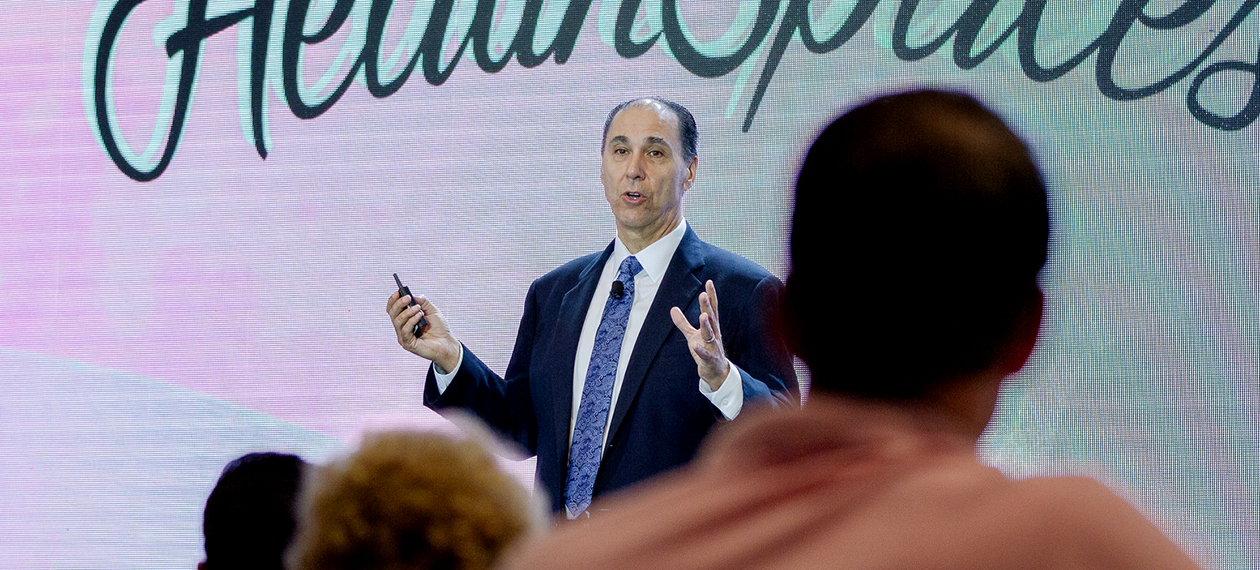Larry Antonucci, MD is CEO of Lee Health, the third largest nonprofit public health system in the country. At HealthSpaces ‘18 he gave a far-reaching presentation that looked at the current state of healthcare in terms of trends, technology, and leadership; how disruptive changes in the healthcare industry could affect facilities leaders; and what they can do to prepare for it.
Dr. Antonucci identified five key areas that trends in healthcare are currently disrupting—the payer market, care delivery, consumerism, competition, and consolidation and scale—and addressed them one by one.
The Payer Market Refuses to Pay
First the payer market: Market transformation means revenue pressure for health systems. As it stands, the largest insurer in each market holds an overwhelming majority of the market share in each state for the majority of states. High-deductible health plan enrollment is on the rise, now up to 43% of all those insured. Government payers are also on the rise with enrollment in Medicare and Medicaid plans increasing, and both governmental and commercial payers are getting tougher on high hospital prices. While some would point to the "overuse" of hospitals and emergency rooms as the reason for these high costs, Antonucci said the problem really is that American hospitals just charge much more for services that are cheaper in other countries, and now insurers are starting to refuse to pay for certain services.
"The shift to value is continuing but it's unpredictable," he said. Provider-sponsored health plans and direct contracting are new models that are emerging, but so far they have had mixed success. Provider-sponsored health plans have struggled to become profitable, and several have already sold or gone out of business since 2010. Direct contracting seems to have more promise—with three percent of employers currently utilizing this method but 26% saying they are considering it—but this system still needs to build the expertise to manage claims and care.
Care Delivery Shifts from Volume to Value
In care delivery, the second key area Antonucci identified, a dramatic shift is happening with physicians. For the first time ever, the majority of physicians do not have an ownership interest in their practices. Moreover, physician compensation is shifting from volume to value.
"That has been a tricky transition," he said. "We really need to help them understand they can succeed in a value-based world; it's just different."
While the coming years will bring a physician shortage, many states are allowing non-physician providers (such as nurse practitioners) to take on more physician responsibilities. Advances in artificial intelligence and genomics for precision medicine will centralize routine diagnostic functions so they're not one-size-fits-all. While digital care is still in its infancy, one-third of ambulatory and 80% of behavioral visits can be addressed through telehealth.
For example, the Kardia app pairs with a $99 device that is installed on the back of a person's phone and records a medical EKG that the person can send to his or her physician for near-immediate review, rather than waiting weeks for an appointment and undergoing a barrage of tests with expensive medical equipment. So now the same diagnostic measure that would cost $3,000-5,000 (not to mention weeks of precious time) is now only $99.
Telehealth solutions also show great promise for behavioral health treatment, which is a huge gap in the care continuum as patients with behavioral health conditions use more medical resources and behavioral healthcare providers are not well integrated into the health system.
The Customer-Patient is Always Right
The third key area that signals a big change in healthcare is the concept of consumerism: Consumer expectations are changing, and providers are struggling to keep up.
"Patients have to pay out of pocket much more than before so they are shopping around," Antonucci explained. "Millennials are now a larger cohort than Baby Boomers and they think and act differently. Their expectations are quite different. They've been 'primed' by Amazon and Uber reducing friction in the service space, which is what they're used to."
Three-quarters of Millennials will check online reviews when shopping around for a service provider, and as many want to see a doctor virtually, which is a drastic departure from Baby Boomers. Most want to be able to book appointments through mobile apps, and one-third have downloaded a health app in the last 30 days.
And yet hospitals are still lagging behind, operating very much in analog still. Only one in five health systems have an online price estimation tool—meaning only 20% of hospitals can give patients any idea in advance of what something might cost them. Only 14% offer digital tools and information to enable customer engagement, only 23% offer a range of virtual and telehealth access points, and only 43% provide messaging between patients and providers.
"There is still a significant gap in what consumers want compared to the capability to deliver that," said Antonucci.
He outlined a "growth roadmap" for health systems to become more competitive as consumerism comes to dominate the healthcare industry. To attract and retain customers, healthcare systems must improve access (including things like 24/7 on-demand access via mobile devices) address pricing transparency and reposition "shoppable" services, build loyalty to retain customers by focusing on the customer experience, all while ensuring the foundation (including leadership and branding) remains solid.
New Competitors Emerge
The fourth major disruptor category in the healthcare industry is made of the disruptors: new competitors that are changing the healthcare ecosystem. Competitors are creating new business models that do not include hospitals, focusing instead on the outpatient and post-acute care that has the biggest profits. At the same time, pharmacies are becoming multi-service health centers and retail clinics and urgent care facilities are receiving huge amounts of venture capital investment. Tech giants like Apple and Amazon are also getting into the healthcare space, and they will find the solutions that hospitals have been too slow to adopt.
"Healthcare is going to look a lot different in five years," he said. "We're not going to see the same things we've seen for decades and decades."

Healthcare Looks More Corporate
Finally, we have the mega-mergers and billion-dollar acquisitions. Providers are seeking unprecedented levels of scale, and that necessity of scale has led to mergers of equals, enabling these newly-merged companies to enhance their brands, expand their geographic reach, build negotiation leverage, add and enhance competencies, drive efficiencies, and improve access to capital. But even the largest providers to emerge from these mergers are still far smaller than new and potential competitors from the likes of Apple, Amazon, CVS, and Walmart.
"What has happened so far is not even close to what's happening on the other side of the corporate world and the change that could mean for healthcare," said Antonucci.
The implications for today's health systems are easy to see, though perhaps harder for an industry that has spent decades doing business as usual. To compete in the Internet economy, health systems need to adopt the strategies of the Internet economy.
So What's a Healthcare System to Do?
First, perfect the product. Health systems need to work continuously to perfect their product just like the “Big Four” do (Apple, Amazon, Facebook, and Google). Focus on a few things, the can't-fails, and do them really well. For too long in the healthcare industry the focus has been on making products that can get reimbursed through insurance companies and not on making great products. Now is the time to change how health systems view healthcare delivery.
Second, health systems need to get serious about costs. The Big Four relentlessly pursue the lowest possible costs. As it is now, healthcare costs are unsustainable—healthcare spending is currently 18% of the national GDP. Average premiums have raised 134% for employers and 167% for workers over the last 15 years. At the same time, operating revenue is falling while operating expenses are rising.
"We need to deliver a platform for a more affordable healthcare system or face major social, political, and economic problems," Antonucci warned.
The third major thing health systems need to do is remove friction—the parts of the experience that create even minor inconvenience. For the Big Four, that means fewer clicks, faster search results, easier payment, and faster delivery. For health systems, it means ease of appointment scheduling, reducing wait times, improving communication with and among providers, reducing repetitive paperwork and confusing billing, and increase digital options for care and communication. Relentlessly pursuing the reduction of frictions will also aid in building customer loyalty.
Finally, health systems must "control the last mile." The "last mile" is all about the customer experience, and that is what companies like Amazon and Uber excel at—taking experiences that weren't even perceived as problematic, like shopping or hailing a cab, and making them seamlessly convenient.
"Healthcare's last mile is the least convenient and least appealing of any industry, and that's our greatest vulnerability," said Antonucci. "We have got to find a way to make that last mile not a chore, but an experience. Whether we are willing to try it or not, we are going to be forced to if we want to stay in the healthcare business. Facility experts need to be thinking about how this will all work together."

Posted by
Collaborate with your Peers!
HealthSpaces is a community for people that plan, design, build and operate spaces where healthcare is delivered.
June 7-9, 2026 | Braselton, GA
Learn More




-4.png)
-Dec-09-2025-05-48-44-4379-PM.png)
-4.png)
-1.png)
-2.png)

Comments